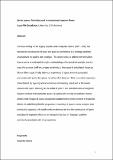Files in this item
Series spaces: revisiting and re-evaluating Inspector Morse
Item metadata
| dc.contributor.author | Donaldson, Lucy Fife | |
| dc.date.accessioned | 2017-01-02T00:32:23Z | |
| dc.date.available | 2017-01-02T00:32:23Z | |
| dc.date.issued | 2016-01 | |
| dc.identifier | 234253731 | |
| dc.identifier | 48b68818-c4c6-44f4-99c2-e31da99f20af | |
| dc.identifier | 000409944100001 | |
| dc.identifier.citation | Donaldson , L F 2016 , ' Series spaces: revisiting and re-evaluating Inspector Morse ' , Journal of Popular Television , vol. 4 , no. 1 . https://doi.org/10.1386/jptv.4.1.3_1 | en |
| dc.identifier.issn | 2046-9861 | |
| dc.identifier.other | ORCID: /0000-0002-4029-7465/work/61978876 | |
| dc.identifier.uri | https://hdl.handle.net/10023/10030 | |
| dc.description | This article is one of the outcomes of the research project ‘Spaces of Television: Production, Site and Style’, funded by the Arts and Humanities Research Council (grant number AH/H018662) from 2010 to 2015 and based at the University of Reading. | en |
| dc.description.abstract | Previous writing on the hugely popular series Inspector Morse (1987–1998) has stressed the presentation of space and place as conforming to a heritage aesthetic, characterized by quality and nostalgia. This article seeks to address how television drama can be re-evaluated through a methodology of longitudinal analysis, and the ways this process itself encourages sensitivity to how space is articulated. Inspector Morse offers a specifically televisual experience of space, involving repeated encounters with particular spaces by virtue of its long run. This is a spatial experience characterized by layering and accumulation of meaning, a textured or thickened contact with space. Drawing on the detail of pattern and embellishment arising from repeated contact with particular spaces, it explores the density of aesthetic choices which create images of spatial disjunction suitable to the generic context of Inspector Morse. In underlining that the programme’s handling of space is more complex than previously suggested, this article seeks to demonstrate that the construction of space and place in Inspector Morse is not limited to the kind of ‘heritage’ qualities commonly associated with the programme. | |
| dc.format.extent | 388757 | |
| dc.language.iso | eng | |
| dc.relation.ispartof | Journal of Popular Television | en |
| dc.subject | Inspector Morse | en |
| dc.subject | Space | en |
| dc.subject | Aesthetics | en |
| dc.subject | Place | en |
| dc.subject | Detective series | en |
| dc.subject | Television | en |
| dc.subject | Texture | en |
| dc.subject | PN1990 Broadcasting | en |
| dc.subject.lcc | PN1990 | en |
| dc.title | Series spaces: revisiting and re-evaluating Inspector Morse | en |
| dc.type | Journal article | en |
| dc.contributor.institution | University of St Andrews. Film Studies | en |
| dc.contributor.institution | University of St Andrews. Centre for Ancient Environmental Studies | en |
| dc.identifier.doi | 10.1386/jptv.4.1.3_1 | |
| dc.description.status | Peer reviewed | en |
| dc.date.embargoedUntil | 2017-01-01 | |
| dc.identifier.url | http://www.intellectbooks.co.uk/journals/view-Journal,id=216/ | en |
This item appears in the following Collection(s)
Items in the St Andrews Research Repository are protected by copyright, with all rights reserved, unless otherwise indicated.

